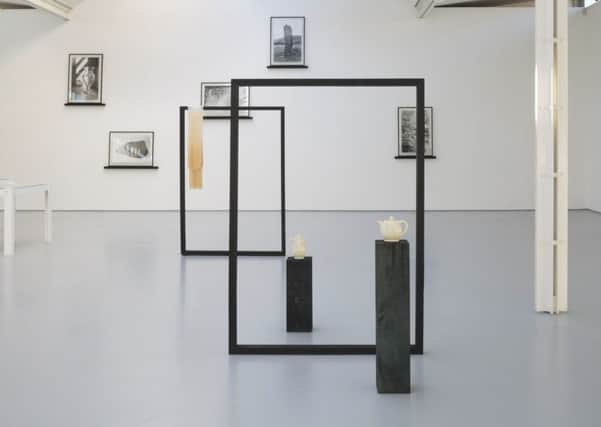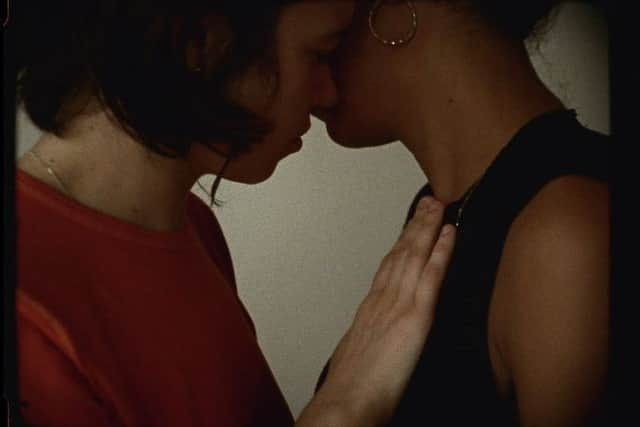Art reviews: Lorna Macintyre and Margaret Salmon at Dundee Contemporary Arts


Lorna Macintyre: Pieces of You Are Here, Dundee Contemporary Arts ****
Margaret Salmon: Hole, Dundee Contemporary Arts ***
There are some very fine photographs in Lorna Macintyre’s new exhibition for Dundee Contemporary Arts. There is a crystal vase with the light shining through it, a standing stone bearing ancient carvings, the glorious texture in the frayed edges of a doormat, a view through a succession of doorways to the light beyond.


Advertisement
Hide AdAdvertisement
Hide AdGlasgow-based Macintyre has an eye for texture and light, for how to frame an image. She is drawn to the past as well as the present, and is interested in the traces we leave, whether personally or archaeologically. One of the starting points for this body of work is a terracotta tile from the collection of Dundee’s McManus Art Gallery & Museum, excavated from Carpow Roman Fort at Abernethy, which bears the imprint of a dog’s paw, which walked over it when the clay was still wet. She describes it as “a kind of photograph…a trapping of a moment.” Though many hundreds of years have passed since the print was left, it bears the essence of something indisputably alive.
All that makes a fine exhibition of art photography. But in contemporary art practice, it’s not enough to work within a given medium and do it well, one must also interrogate the medium – photography, perhaps, more than most, because it is assumed to have a measure of objectivity, to represent the “real.” Macintyre, who works in sculpture as well as photography, is perhaps uniquely well placed to interrogate the nature of photograph and physical object, to ask which best represents the physical world.
We see her experimenting with cyanotype, a historic process which typically exposes the thing to be photographed against chemically coated paper in bright sunlight, and silver gelatin prints, and grows crystals using light-sensitive chemicals around a stoneware tea service. Can an image of water, she asks, be created more effectively and evocatively using water and dye than a simple digital print? Answer: seems not, but it was worth a try.
She includes two museum-style cases of objects: axe handles, teaspoons, magician’s rope and so on, as if to interrogate the difference between the photograph and the “real” thing. And she exhibits photographs like sculpture, in three dimensions, leaning against walls or printed on silk and draped from tree branches. The silk works, photographs of vases of flowers stained with fruit juice, are beautiful, trapping a moment in the life cycle of an ephemeral thing.
At the centre of the gallery, and perhaps the argument, is a pair of free-standing frames of burnt oak which “frame” – depending on how you look at them – a pair of stoneware teapots, or perhaps the whole show. Seeing them, your eye irresistably starts to compose a photograph. And there lies the object lesson in subjectivity: every photograph will be different, depending on your perspective.
It is a show of layers, and perhaps the most basic is an interest in the primal artistic gesture: a monoprint showing marks made by the artist with a handful of charcoal; a film showing the hand of her baby daughter flexing and grasping, the earliest attempts at gesture. Our instinct is to make our mark on the world, and Macintyre’s work is a varied, rewarding exploration of that idea.
Much in her work is also intimate, domestic in focus, invested with private meaning. This theme is picked up in the gallery next door by America-born, Glasgow-based Margaret Salmon. Hole is reached by walking through a hole which has been knocked in the gallery wall, implying the opening up of a private realm, a secret space. Salmon has set herself the considerable challenge of trying to capture intimacy, warmth and affection, and communicate these things in art.
She appeals to the senses. In the dimly lit space, three electric radiators are literally creating warmth (“Is this art?” I heard one puzzled visitor ask her companion). A sound work, Your breath, features breathing, heartbeats and occasional readings from All About Love by feminist theorist bell hooks. As far as environments go, it’s less than successful: we still have to sit on hard chairs to watch the films, and the sound work is a little creepy. But Salmon works principally in film, and it is the films here which most deserve our attention.
Advertisement
Hide AdAdvertisement
Hide AdI you we me us is a work on two monitors which seems to create a conversation between words and gestures, investigating different ways of communicating closeness to a partner, a family member, a friend. Then, further into the darkened space, we encounter Two, Salmon’s film showing intimate sexual encounters between three committed couples. The aim is less to show the act itself than the qualities of intimacy, tenderness and respect.
Watching this film provokes a range of questions: Should I be watching this? Does it make me an intruder, a voyeur? Or not, given that everyone involved consented to the film being made? And, by the way, what kind of trust do you need between artist and subject before allowing your most intimate moments to be commited to celluloid?
The temptation is to talk about Two in terms of ideas, art theory, or even art history, since its depiction of the human body invites comparisons to everyone from Titian to Jenny Saville. This would allow us to remain at a safe distance, but this is not Salmon’s intention. She wants to say something about love, about what makes a loving, supportive relationship. Her camera treats her subjects with the same respect, sympathy and fascination as they seem to treat one another, and she invites the viewer to do the same. She has set herself a considerable challenge, and produced a work which is unique and rather beautiful.
Whether her success can be attributed to the distinctiveness of the female gaze is more problematic. The text accompanying the show describes the film as “an antidote to dominant patriarchal visual culture,” as if a man working with the same material would automatically produce something more voyeuristic, less respectful.
While representations of the female gaze are essential, and welcome, there are assumptions here which make me uncomfortable. More uncomfortable, it has to be said, than sitting in a gallery watching a film of people having sex.
Both shows run until 24 February